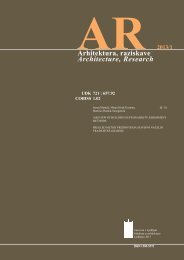Revija 2005/1 v PDF - Fakulteta za arhitekturo - Univerza v Ljubljani
Revija 2005/1 v PDF - Fakulteta za arhitekturo - Univerza v Ljubljani
Revija 2005/1 v PDF - Fakulteta za arhitekturo - Univerza v Ljubljani
Create successful ePaper yourself
Turn your PDF publications into a flip-book with our unique Google optimized e-Paper software.
AR 2oo5 / 1Toma NovljanCILJI - MATRICA - UKREPI:STANOVANJSKO OBMOÈJE RAKOVNIKGOALS MATRIX MEASURES:THE RESIDENTIAL AREA RAKOVNIKraziskava, researchpovzetekVelik del slovenskega stanovanjskega fonda predstavljajo objekti,ki datirajo v petdeseta in šestdeseta leta prejšnjega stoletja. Globalnespremembe, sprememba drubene ureditve in kulture bivanja,sodobni stanovanjski standardi in <strong>za</strong>konodaja s podroèjagradbeništva <strong>za</strong>htevajo ukrepe, ki bi obstojeèe stanovanjske objekteprilagodili moderni rabi. Zaradi specifiènosti posameznihstanovanjskih naselij in posameznih veèstanovanjskih objektov jepotrebno izdelati univer<strong>za</strong>len sistem vrednotenja in iz tega izhajajoèsistem prenovitvenih ukrepov. Sistem bi upošteval materialne innematerialne danosti posameznih okolij, v katerih se nahajajostanovanjski objekti, jih analiziral ter na podlagi tega predlagalukrepe <strong>za</strong> prenovo. Posamezne danosti in potrebne spremembe soobravnavane z veè razliènih vidikov, ki so med seboj primerljivi. Togenerira posebno matriko, ki s pomoèjo vrednotenja in medsebojneprimerjave vhodnih podatkov išèe primerne pove<strong>za</strong>ve in iz tegaizhajajoèe mone ukrepe.doseeni cilji, namen in rezultatiPrikaz monosti <strong>za</strong> izdelavo univer<strong>za</strong>lnega sistema primerjavmaterialnih (naravnih in grajenih) ter nematerialnih danostiizbranega stanovanjskega okolja na podlagi medsebojne primerjavein smiselnosti razliènih ukrepov prenove kolektivnih stanovanjskihambientov.Doseèi pozitiven odnos do monosti izboljšave in s tem ohranitvevrednosti obstojeèega stanovanjskega fonda. Dvigniti nivo bivalnekulture " povpreènega"stanovalca. Stanovanjskim obmoèjemomogoèiti trajnosten razvoj, prilagodljivost spremembam,pozitiven odnos do ojega in širšega naravnega okolja v katerem senahajajo. Vzpostaviti enotnejša merila <strong>za</strong> vrednotenje stanja ininstrumente <strong>za</strong> izvedbo potrebnih posegov v prostor.Pripomoèek naèrtovalcem in oblikovalcem stanovanjske politike in<strong>za</strong>konodaje. Preizkusni instrument <strong>za</strong> izvedbo predhodnih" laboratorijskih"študij brez pretiranega in vèasih tveganegavkljuèevanja, tj. vznemirjanja neposrednih uporabnikov izbranegaprostora. Osnova <strong>za</strong> dopolnjevanje in prilagajanje prostorskih meril.problematika v arhitekturi, umestitevobravnavane teme v te tokove in njen pomenPredmet obravnave predstavljajo neurejene razmere prenovestanovanjskega fonda v Sloveniji in vpliv le-teh na arhitekturnevidike prenove kot poseben problem. Namen reševanja tegaproblema pa pomeni povezovanje arhitekturnih vidikov v smislutrajnostnega razvoja bivalnega okolja pri nas. Prenoviteljska praksanaj bi prestopila prag površnih, " kozmetiènih"posegov in vstopila vprostor celostnih, konceptualnih rešitev, s ciljem poveèati stopnjocelovitosti tudi z arhitekturnega vidika. V nalogi uporabljenametoda temelji na razèlenitvi in analizi podatkov SURS in njihoviprimerjavi s podobnimi relevantnimi študijami. Predlog sinteznihukrepov sledi iz ocene trenutnih razmer in oblikovanja gradbenoarhitekturnih usmeritev v pove<strong>za</strong>vi z arhitekturno-urbanistiènimi,gradbeno-tehniènimi in drubeno-prostorskimi. Stanje, obseg instarost slovenskega stanovanjskega fonda tako rezultira v nujnostipotrebe po prenovi z arhitekturnih vidikov in kot tak predstavljapraktièno uporaben prispevek k sistemskim ukrepom prenove.kljuène besedematrika, nivoji, prenova, stanovanja, ukrepi, zgradbesummaryA significant share of the Slovene housing stock is represented bybuildings dating to the 50s and 60s of the last century. Globalchanges, changes of social order and living culture, contemporaryhousing standards and legislature dealing with building demandmeasures, which would adapt the extant residential buildings tomodern use. Because of the specifics of particular housing estatesand independent multi-apartment buildings a universal system forevaluation has to be devised with a corresponding system ofrehabilitation measures. The system would respect material andimmaterial features of the particular environments with residentialbuildings, analyse them and suggest rehabilitation measures.Particular features and necessary changes are tackled from variousmutually comparative aspects. Thus a special matrix is generated,which uses evaluation and mutual comparison of input data tosearch for suitable connections and possible resultant measures.intentions, goals and resultsTo show possibilities for devising a universal system for comparingmaterial (natural and built) and immaterial features of a selectedresidential environment, which are based on mutual comparisonsand sensibility of various measures for renovating collectiveresidential places. To achieve a positive attitude for the opportunityof refurbishment and corresponding preservation of value of theextant housing stock. To raise the level of residential culture of" average"occupants. Ensure sustainable development, adaptabilityto changes, positive attitudes to wider and immediate naturalenvironments for the residential area's surroundings. To establishharmonised measures for evaluating the condition, as well asinstruments for implementation of necessary interventions. And aidto planners and designers of housing policies and legislature.Testing instrument for conducting preliminary " laboratory"studieswithout exhaustive and sometimes risky inclusion, i.e. bothering, ofimmediate users of a selected place. Basis for amending andadapting planning measures.architectural issues, positioning the topicin ongoing debate and its’ significanceThe researched subject is the disorganised condition for renewal ofthe housing stock in Slovenia and its effect on architectural aspectsof renewal as a special issue. The purpose of resolving the issuemeans integrating architectural aspects, in the sense of sustainabledevelopment of living environments in Slovenia. The practises ofrenewal should exceed the present level of superficial " cosmetic "interventions and enter the space of comprehensive, conceptualsolutions, whose intent is to increase the level ofcomprehensiveness, even from the architectural aspect. The appliedmethod is based on structuring and analysis of official statisticaldata their comparison with similar relevant studies. The proposedsynthesised measures follow from the assessment of presentconditions with formulation of architectural-engineering guidelinesin conjunction with architectural-urbanistic, engineering-technicaland social-spatial guidelines. From the architectural aspects, theage, scope and extent of the Slovene housing stock thus result innecessary renewal, also confirming the research's practicalcontribution to the system of renewal measures.key wordsmatrix, levels, renewal, housing, measures, buildings.73
















